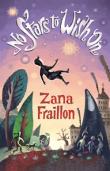AustLit
Latest Issues
AbstractHistoryArchive Description
'Each kid only has one pair of shoes here. Number 49's shoes are a pretty good fit for me and I know they're new because they still have that plastic smell. But the real Number 49 is quite a bit bigger than I am, because his pants keep falling down on me. I wish he would come back, so that I could go home.
'Jack loves telling jokes, but not many people laugh at them in the orphanage. Will he ever be reunited with his mother and sister, his great-aunts and great-grandmother, back at home?' (Publication summary)
Publication Details of Only Known VersionEarliest 2 Known Versions of
Other Formats
- Dyslexic edition.
- Large print.
Works about this Work
-
The Child Lost Beneath History in Zana Fraillon’s No Stars to Wish On and The Bone Sparrow
2018
single work
criticism
— Appears in: Journal of the European Association for Studies on Australia , vol. 9 no. 2 2018;'This paper discusses some of the theories proposed in my monograph The Lost Child in Literature and Culture. It looks at the importance of the lost child figure in disrupting established narratives of history and culture. Using Fraillon’s two novels I discuss how the child is at the centre of abuses of power and also look at the author’s use of alternative forms of language and communication to counter this. The article locates Fraillon’s narratives within fairy-tale tropes such as a child’s quest, while arguing that such tales have also embodied endemic cruelty towards children. Ancient oral folk tales are entwined in the same narrative as modern media. The EASA Conference focused on the rise of nationalism, and the connections between Europe and Australia. The figure of the lost child is sadly pervasive in both parts of the world, showing the inter-connectedness of all our stories. The practice of Child Migration, referred to in this article, is an example of how lost children have been forcibly removed from Europe to Australia as one facet of a system of control.'
Source: Abstract.
-
Know the Author : Zana Fraillon
2018
single work
interview
— Appears in: Magpies : Talking About Books for Children , May vol. 33 no. 2 2018; (p. 8-10) Reading The Bone Sparrow, Zana Fraillon's novel set in a detention centre, is a heightened experience; exquisite for its poetic sensibility and distressing for its bleak setting. In it, the child narrator Subhi's mother, Maá, tells him if everyone would listen to the stories deep down inside the earth, we would hear the whisperings of everything there is to hear, and if everyone did that, then maybe we wouldn't all get stuck so much. (Introduction) -
Younger Readers
2014
single work
review
— Appears in: Good Reading , May 2014; (p. 66)
— Review of No Stars to Wish On 2014 single work children's fiction -
[Untitled]
2014
single work
review
— Appears in: Magpies : Talking About Books for Children , May vol. 29 no. 2 2014; (p. 34)
— Review of No Stars to Wish On 2014 single work children's fiction
-
[Untitled]
2014
single work
review
— Appears in: Magpies : Talking About Books for Children , May vol. 29 no. 2 2014; (p. 34)
— Review of No Stars to Wish On 2014 single work children's fiction -
Younger Readers
2014
single work
review
— Appears in: Good Reading , May 2014; (p. 66)
— Review of No Stars to Wish On 2014 single work children's fiction -
Know the Author : Zana Fraillon
2018
single work
interview
— Appears in: Magpies : Talking About Books for Children , May vol. 33 no. 2 2018; (p. 8-10) Reading The Bone Sparrow, Zana Fraillon's novel set in a detention centre, is a heightened experience; exquisite for its poetic sensibility and distressing for its bleak setting. In it, the child narrator Subhi's mother, Maá, tells him if everyone would listen to the stories deep down inside the earth, we would hear the whisperings of everything there is to hear, and if everyone did that, then maybe we wouldn't all get stuck so much. (Introduction) -
The Child Lost Beneath History in Zana Fraillon’s No Stars to Wish On and The Bone Sparrow
2018
single work
criticism
— Appears in: Journal of the European Association for Studies on Australia , vol. 9 no. 2 2018;'This paper discusses some of the theories proposed in my monograph The Lost Child in Literature and Culture. It looks at the importance of the lost child figure in disrupting established narratives of history and culture. Using Fraillon’s two novels I discuss how the child is at the centre of abuses of power and also look at the author’s use of alternative forms of language and communication to counter this. The article locates Fraillon’s narratives within fairy-tale tropes such as a child’s quest, while arguing that such tales have also embodied endemic cruelty towards children. Ancient oral folk tales are entwined in the same narrative as modern media. The EASA Conference focused on the rise of nationalism, and the connections between Europe and Australia. The figure of the lost child is sadly pervasive in both parts of the world, showing the inter-connectedness of all our stories. The practice of Child Migration, referred to in this article, is an example of how lost children have been forcibly removed from Europe to Australia as one facet of a system of control.'
Source: Abstract.





